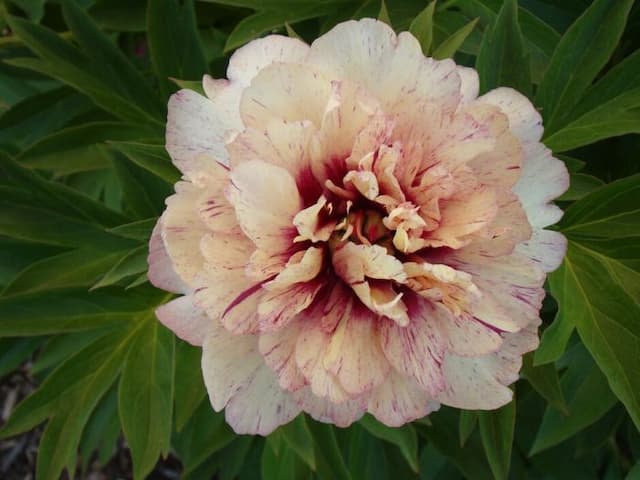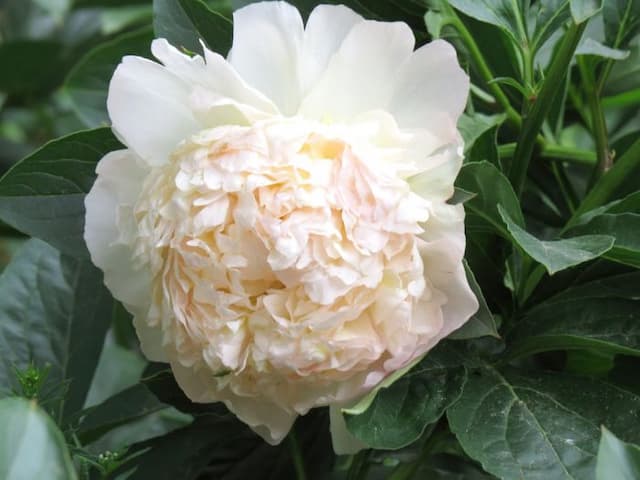Chinese Peony Paeonia lactiflora 'Riches and Fame'

ABOUT
The Paeonia lactiflora 'Riches and Fame', commonly known as the peony 'Riches and Fame', is a cultivated variety known for its striking floral display. This plant features large, bomb-type flowers with layered petals that are often compared to rosettes. The blooms are a deep and luscious pink, which can appear almost red, giving them a rich, velvety texture that is both eye-catching and luxurious. The outer guard petals are broad and may have a lighter shade, sometimes fading to softer pink edges, which adds depth and contrast to the flowers. At the center, the petals may tighten into a denser sphere, adding to the fullness of the flower’s appearance. The leaves of 'Riches and Fame' are glossy and deeply green, providing a lush backdrop that accentuates the beauty of the blossoms. The foliage emerges in early spring, initially showcasing a fresh hue that matures to a deeper color as the season progresses. Peony leaves are typically broad and divided into leaflets, with a smooth or subtly textured surface that catches the light. The plant's overall form is upright and bushy, presenting a stout and structured look, which makes it an attractive addition to garden borders and floral arrangements. As the peony 'Riches and Fame' comes into bloom, the contrast between the sumptuous flowers and the verdant foliage creates a striking visual spectacle that is highly prized by gardeners and flower enthusiasts. The plant is celebrated not only for its aesthetic qualities but also for the sweet, often heady scent that the flowers emit, making it a delight to the senses.
About this plant
 Names
NamesFamily
Paeoniaceae
Synonyms
Chinese Peony, White Peony
Common names
Paeonia lactiflora.
 Toxicity
ToxicityTo humans
The common name for Paeonia lactiflora is peony. Peonies are not considered highly toxic to humans. However, ingesting large quantities of peony parts might cause mild gastrointestinal discomfort, including nausea or diarrhea. It is generally recommended to avoid eating any parts of ornamental plants due to potential adverse effects.
To pets
For pets, peonies, the common name for Paeonia lactiflora, can be toxic. If a pet ingests parts of a peony, it might exhibit signs of toxicity such as vomiting, diarrhea, or drooling. In more severe cases, ingestion can lead to depression and lack of coordination. If you suspect your pet has consumed any part of a peony plant, it is advisable to contact a veterinarian.
 Characteristics
CharacteristicsLife cycle
Perennials
Foliage type
Deciduous
Color of leaves
Green
Flower color
Pink
Height
2-3 feet (0.6-0.9 meters)
Spread
2-3 feet (0.6-0.9 meters)
Plant type
Herb
Hardiness zones
3-8
Native area
China
Benefits
 General Benefits
General Benefits- Ornamental Appeal: Features large, attractive flowers that can enhance the beauty of gardens and landscapes.
- Variety of Colors: Blooms come in a range of colors, adding visual interest to outdoor spaces.
- Perennial Growth: As a perennial, it returns each year, reducing the need for annual replanting.
- Seasonal Interest: Marks the seasons with its flowering period, indicating the arrival of spring or summer.
- Low Maintenance: Requires minimal upkeep once established, making it suitable for less attentive gardeners.
- Cut Flowers: Provides long-lasting cut flowers for arrangements and bouquets.
- Attracts Pollinators: Draws in bees, butterflies, and other beneficial pollinators, promoting biodiversity.
- Cold Hardy: Can survive in colder climates, broadening the regions where it can be grown.
- Privacy and Borders: Can be used to create natural borders or screens for privacy in the garden.
- Companion Planting: Compatible with a range of other plants, helping to create balanced and attractive garden designs.
 Medical Properties
Medical Properties- Anti-inflammatory: The root of the peony is traditionally believed to have anti-inflammatory properties.
- Antispasmodic: Peony may help in reducing muscle spasms.
- Anxiolytic: Some compounds in peony are thought to possess mild sedative effects that could potentially alleviate anxiety.
- Immunomodulatory: Peony may influence immune system regulation.
 Air-purifying Qualities
Air-purifying QualitiesThis plant is not specifically known for air purifying qualities.
 Other Uses
Other Uses- The roots of the peony can be used in making natural dyes, offering shades ranging from light tan to deeper browns.
- Peony petals can be infused in water to create a fragrant peony water, which is sometimes used in gourmet cooking for its floral essence.
- Dried peony petals can be incorporated into potpourris to add a pleasant aroma to a room.
- The petals are also edible and can be used to adorn salads and desserts for an elegant presentation.
- Peony flowers are sometimes used in crafting eco-friendly confetti that biodegrades and adds a colorful touch to celebrations.
- The seed pods of peonies, once dried, can be used in ornamental autumn arrangements or as part of wreaths.
- The firm stems of peonies can be used in basket-weaving, offering a sturdy and natural material for handcrafting.
- Petals of the peony can be pressed and included in handmade papers, providing a unique texture and floral touch to the paper.
- Peony plants can function as companions to certain vegetables in the garden, helping to attract pollinators which can improve crop yields.
- After blooming, peony leaves provide a lush, green backdrop in garden beds, serving as living mulch to help retain soil moisture and suppress weeds.
Interesting Facts
 Feng Shui
Feng ShuiPeonies are often associated with wealth and honor in Feng Shui, so Paeonia lactiflora can be used to stimulate the energies of prosperity and recognition. It’s best placed in the wealth corner of the home, which is the southeast, or in the living room to enhance social status and personal growth. Ensure it’s well-cared-for to maintain positive chi flow.
 Zodiac Sign Compitability
Zodiac Sign CompitabilityPeonies are not used in astrology practice.
 Plant Symbolism
Plant Symbolism- Wealth: The name 'Riches and Fame' directly points to a symbolism of wealth, prosperity, and material abundance.
- Honor and High Status: Fame is associated with recognition and high standing in society, and the peony often symbolizes honor and the respect of others.
- Romance and Love: Peonies, in general, are often used in weddings and romantic occasions, symbolizing a happy marriage and the bliss of love.
- Beauty: With its lush, full blooms, the peony represents ultimate beauty and grace, often associated with an ideal of feminine beauty.
- Good Fortune: In traditional Eastern symbolism, peonies are seen as an omen of good fortune and a happy life, which aligns with its connotations of riches and fame.
- Compassion: Peonies can also represent compassion and empathy, drawing connections to the softness and nurturing aspect of its appearance.
 Water
WaterThe peony, specifically Paeonia lactiflora 'Riches and Fame', should be watered deeply once a week, ensuring the soil is moist but not soggy, which usually equates to about 1 inch of water. During hot, dry periods, increase the frequency to twice a week, providing the same amount of water. Adjust watering to be less frequent during periods of rain or cooler weather to prevent overwatering. Water at the base of the plant to keep the foliage dry and prevent fungal diseases. It is important not to over-water as peonies do not like standing water, which can lead to root rot.
 Light
LightPeonies, such as Paeonia lactiflora 'Riches and Fame', thrive in full sun to light shade. They require at least 6 hours of sunlight daily to bloom properly. The ideal spot is in an area that receives morning sunlight and some afternoon shade, especially in regions with hot summers. Avoid planting in deep shade as this will impede flowering and may lead to weak, leggy growth.
 Temperature
TemperaturePeonies like Paeonia lactiflora 'Riches and Fame' perform best in temperatures ranging between 65°F and 75°F. They can endure winter temperatures down to about -20°F and will survive occasional summer highs up to 90°F. These plants require a period of winter chill for successful blooming, so they are well-suited to climates with distinct seasons.
 Pruning
PruningPeonies, including Paeonia lactiflora 'Riches and Fame', should be pruned to remove spent flowers after blooming to maintain a tidy appearance and prevent seed formation that can sap the plant's energy. In late fall or early spring, prune back the foliage to the ground to remove any dead leaves and stems, which helps prevent disease. Pruning is typically done annually, after the first frost in fall or before new growth appears in spring.
 Cleaning
CleaningAs needed
 Soil
SoilPeonies like well-draining, fertile soil with a pH of 6.5 to 7.0. A mix of two-thirds garden soil and one-third compost or well-rotted manure is ideal for Chinese Peony 'Riches and Fame'.
 Repotting
RepottingChinese Peony 'Riches and Fame' generally does not need frequent repotting as it is a perennial plant. It should be divided or repotted only if it becomes overcrowded, about every 5 to 10 years.
 Humidity & Misting
Humidity & MistingChinese Peony 'Riches and Fame' does well with average outdoor humidity and does not require any special humidity adjustments.
 Suitable locations
Suitable locationsIndoor
Ensure bright light, cool temps, and plant in deep pots.
Outdoor
Plant in full sun, rich soil; ensure winter chill for blooms.
Hardiness zone
3-8 USDA.
 Life cycle
Life cycleThe life cycle of Paeonia lactiflora 'Riches and Fame', commonly known as Chinese peony, begins with seed germination, which occurs in spring or after stratification if the seeds have experienced a period of dormancy. Following germination, a root system develops along with a shoot that emerges above the soil, gradually forming a set of true leaves. In its early years, the peony focuses on building a strong root system and foliage growth, with little to no flowering. Once mature, which can take several years, the plant enters a phase of annual blooming, typically in late spring to early summer, displaying large, fragrant flowers that attract pollinators. After flowering, the plant sets seeds in pods, which if not collected, will eventually dry and release seeds to perpetuate the cycle. As the growing season ends, the peony's herbaceous stems die back to the ground in fall, and the plant enters a period of dormancy during winter, storing energy in its roots for the next season's growth.
 Propogation
PropogationPropogation time
Late summer
Propogation: The most popular method of propagating the Paeonia lactiflora 'Riches and Fame', commonly known as peony, is through division. This process is typically carried out in the fall after the plant has gone dormant. To propagate by division, one should carefully dig up the peony plant, making sure to keep a generous amount of soil around the roots to avoid damage. The clump is then gently cleaned and the root ball is cut into sections, with each section having at least three to five eyes, which are the growth nodes. These sections can be replanted immediately, ensuring that the eyes are set no more than 2 inches (approximately 5 centimeters) deep. This allows for the peony to establish itself before the cold of winter sets in, giving it a strong start for the following spring.









![Peony [Red Sarah Bernhardt]](/_next/image?url=https%3A%2F%2Fplants-admin.emdemapps.com%2Fimages%2Fplants%2F%2Fimages%2F604b5369d170e.png&w=640&q=75)